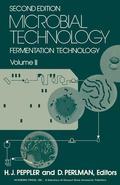Microbial Technology: Fermentation Technology, Second Edition is a collection of papers that deals with fermentations and modifications of plant or animal products for foods, beverages, and feeds. The papers also review microbial technology: general principles, culture selection, laboratory methods, instrumentation, computer control, product isolation, immobilized cell usage, economics, and microbial patents. Several papers explain the process of fermentation and food modification in cheese, soy sauce, vinegar, mushroom, inocula for blue-veined cheeses, and blue cheese flavor. One paper discusses the technology of isolation, production, and application of microbial cultures which are commercially available or imminent as inocula for the treatment of wastes, The paper describes these cultures in terms of product characteristics, types of cultures, and application guidelines for waste treatment. Another paper outlines the procedures used by investigators involved in microbial reaction engineering, as follows: (1) identification of main products and substrates: (2) stoichiometry of the process; (3) kinetics and process rate; and (4) reactor design. One paper cites examples of immobilized cell systems utilized to prepare fine chemicals, such as the research of Chibata et al. (1975) and Yamamoto et al (1976, 1977). The collection is suitable for food technologists, bio-chemists, cellular biologists, micro-biologists, and scientists involved in food production, medicine, agriculture, and environmental control.


